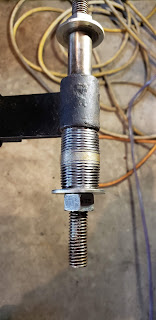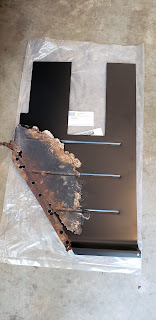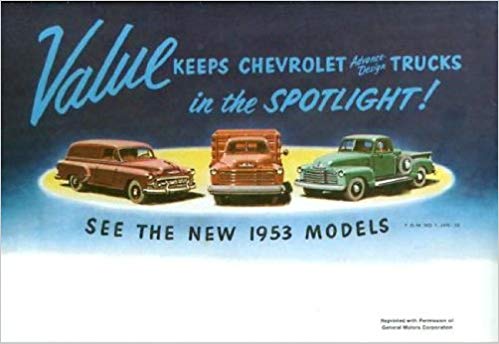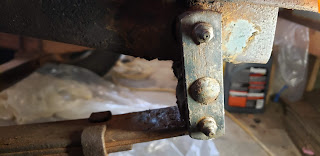Hello Gray Ghost Fans!
I've been able to get out into the garage this week and do a little work on replacing that worn out front shackle. As you may remember, I was waiting for delivery of parts. They came in and looked pretty good:
 |
| NOS Parts Box |
 |
| NOS Front Shackle Parts |
Nothing like using NOS (New Old Stock) parts. You know they'll fit, assuming that you bought the correct version and no one, over the last 70 years, put the wrong parts in the box that services your truck!
Time to get to rebuilding! First up, pressing in the bushings. To do that, I'm using the same tool that I used to remove the old ones. It's a 5/8" piece of all thread with a washer and nut on either end and a piece of 1" ID pipe on the far end. I'm using the old bushing as a spacer to help drive the new bushing into place. The tool assembled, both the spring eye and bushing pre-greased and ready to press the new bushing in, it looked like this:
 |
| Seating the new bushing |
Both bushings installed looked like this:
 |
| Bushings installed |
Next up, pre-greasing inside the threaded bushing and the shackle pin, then threading it onto the shackle bushing. It looked like this when installed:
 |
| Shackle pins installed |
All of that was the easy part.... Now to add the sides to the shackle. This will entail aligning all of the openings and pins and getting the shackle bolt installed to hold it all together.
Try #1 did not line up! Somehow, the spring had moved about 1 1/2 inches inboard.... Can I move it by hand? No, I can not! What to do?
Try #2: get creative! Down to the basement, back with a C clamp and an extra long bolt. The thought here is to get the shackle sides in place on one pin each, use the extra long bolt to keep the sides from falling off and them use the C clamp to move the spring outboard and (hopefully) into the other pins.
Did it work? Yes it did! It was an incremental process, requiring some gentle taps with the ball peen hammer (hey, the shop manual says to do that!) and further tightening of the nuts on the extra long bolt. Once the space between the shackle sides had been closed enough for the regular bolt to fit, I switched to that bolt. At that point both shackle sides had engaged all four points on the shackle pins and it was just a matter of properly tightening the bolts.
Oh yeah, I forgot to mention what started this whole evolution.... Did you remember? Yup, the darned cork grease seal! Thankfully, I only forgot to mention it here. In the assembly process I remembered! The Factory Assembly Manual requires 8-10 ft lbs of torque on the bolt. Got out the old torque wrench, did what the FAM requires and when said and done, it looked like this:
 |
| Fully Assembled Shackle |
 |
| Neoprene Grease Seals Installed |
 |
| Rotten Piece Over Replacement Piece |












